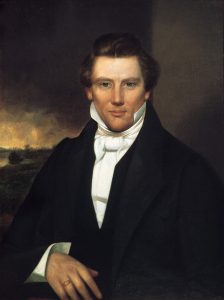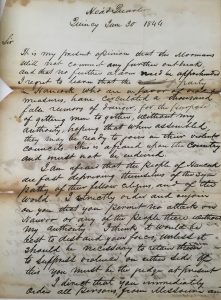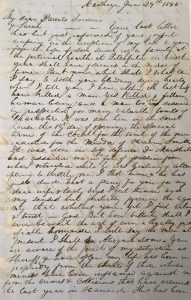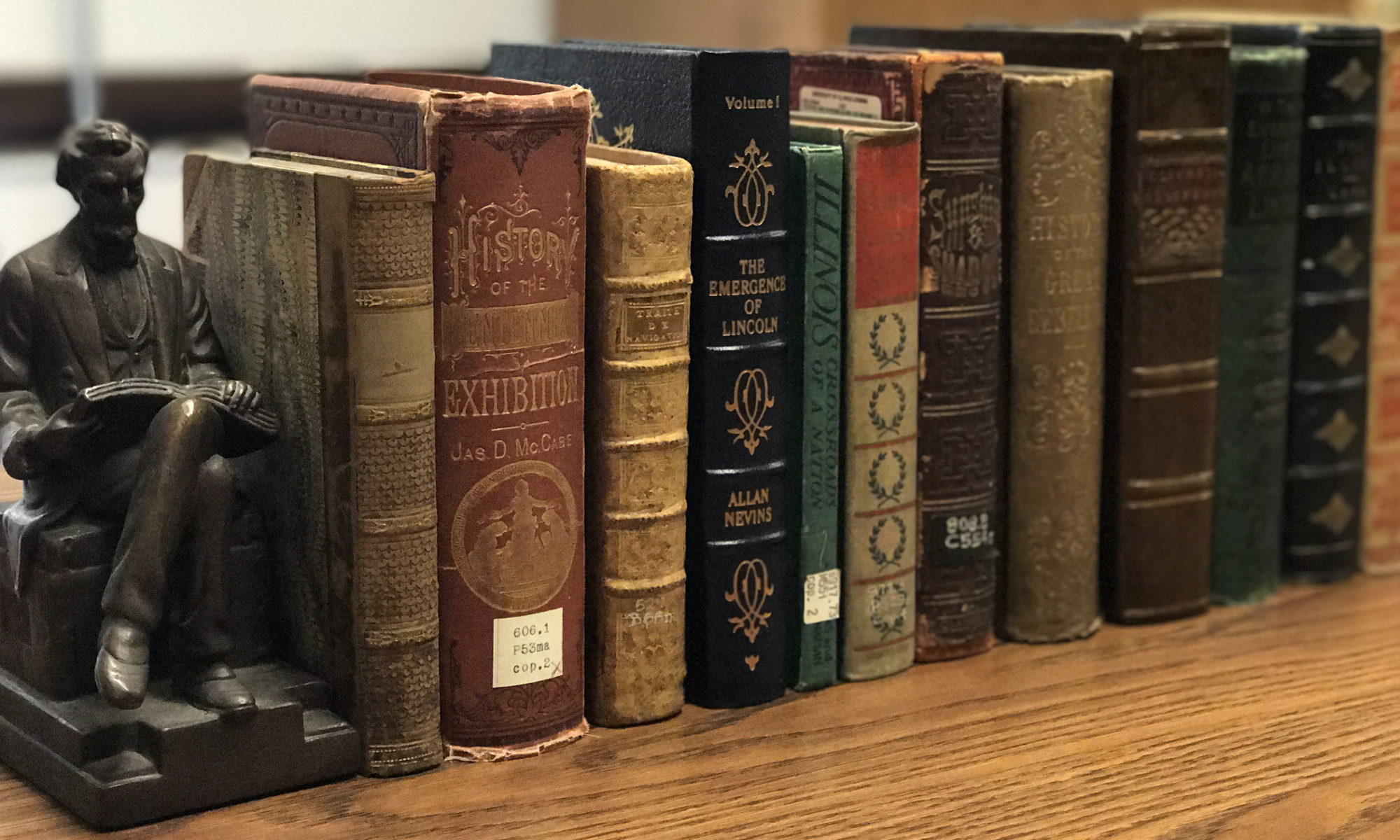Throughout the month of October, our focus is on crime in Illinois history. Follow along here and on our social media to learn more about the crimes, cases, and trials that have left their mark on Illinois.

In 1839, Joseph Smith, the founder of the Church of Jesus Christ of Latter-day Saints, led the Mormons to Illinois after their expulsion from Missouri. As Smith and his followers established a settlement at Nauvoo, many Illinoisans feared that the group’s religious authority had extended too far into politics. The huge wave of immigration to Nauvoo had created a massive voting bloc with the power to turn the tide of elections. The Smiths had many enemies, particularly in the press where anti-Mormon sentiments and denunciations of Joseph Smith stirred dissent among the citizens.
After ordering the destruction of an anti-Mormon newspaper’s printing press in response to some particularly pointed criticisms of his practices, the Smiths were charged with inciting riot, leading to Joseph Smith’s declaration of martial law in Nauvoo and a dramatic flight across the Mississippi River. Illinois Governor Thomas Ford urged the brothers to come to Carthage and surrender to the authorities. With promises of safety from Ford, the brothers eventually surrendered in Carthage where they were charged with treason. On June 27, 1844, an armed mob attacked the Carthage jail that held Joseph and his brother Hyrum. The Smiths attempted to defend themselves but were overtaken as the mob stormed and surrounded the jail, and both men were shot to death.

Five defendants went to trial for the murders, all prominent men in the community with strong reputations and political ambitions. It was common knowledge that the Smiths had been killed by men from the Warsaw militia, and four of the defendants were officers in this militia. The fifth, Thomas C. Sharp, was the spokesperson for the Warsaw Signal, a newspaper with strong anti-Mormon sentiments. The paper had called for the expulsion of the Mormons and violence against the Smiths before the attack in Carthage, and after the murder of the Smiths the paper called the incident justified.
The defense’s first strategy was to reject and annul the original jury and select an entirely new panel of non-Mormon jurors. Once this new panel was established, the primary strategy for the defense was to attack the verity of the prosecution’s witnesses and declare that there was not enough evidence for a conviction. Two weeks before the trial, the lead witness for the prosecution, William M. Daniels, published a booklet about his eyewitness account of the murder. He claimed to have seen everything from militiamen plotting the attack to the murders themselves. Certain portions of the account seemed far-fetched and implausible, such as the description of a light bursting from the heavens to prevent Joseph Smith’s body from being maimed after his death:
This light, in its appearance and potency, baffles all powers of description. The arm of the ruffian, that held the knife, fell powerless; the muskets of the four, who fired, fell to the ground, and they all stood like marble statues, not having the power to move a single limb of their bodies.
Descriptions such as these, and public access to the printed account prior to the trial, gave the defense the opportunity to study it in advance and prepare to discredit Daniels’s testimony with a brutal cross-examination. Other witnesses proved to be difficult or withholding, reluctant to face their fellow citizens.
On May 30, 1845, the jury reported that they found the defendants not guilty, and the trial ended in acquittal. The violence did not end with the murders of Joseph and Hyrum. Sheriff Minor Deming was a supporter of Mormon rights who had been elected county sheriff in Hancock with Mormon backing in 1844 after the Carthage attack. Many non-Mormons viewed him as the enemy for his support of Mormon rights, and despite pressure to join the anti-Mormon cause, Deming held fast.

On June 24, 1845, Deming was attacked by a group of men, many of whom had been present at the storming of the Carthage jail. In the struggle, Deming shot and killed one of the main aggressors, Samuel Marshall. Deming was indicted by a non-Mormon grand jury, and with a trial set for October, he resigned as sheriff. Deming died in September before his case went to trial, and his death marked the end of the uneasy peace he had worked to establish and maintain as sheriff. Deming had served as a voice of authority to enforce legal procedure, and in his absence, the maintenance of law and order to mediate between Mormon and non-Mormon issues was abandoned.
With continued prejudice against Mormons and this renewed violence, the Mormon community was destabilized and concerned for their future. The death of Joseph Smith led to a schism in the Latter Day Saint movement that resulted from succession disputes, and many Mormons chose to follow Brigham Young in a mass exodus from Illinois that started around 1847. The murders and perceived mishandling of justice created religious martyrs of Joseph and Hyrum Smith.
You can learn more about the trial and read photocopies of witness accounts in the IHLC’s Joseph and Hyrum Smith Papers, 1844-1845 (MS 278), as well as the personal and official letters of Sheriff Deming in the Minor and Abigail Deming Correspondences, 1826-1849 (MS 944).
IHLC Resources
Beam, Alex. American Crucifixion: The Murder of Joseph Smith and the Fate of the Mormon Church. New York: Public Affairs, 2014. Call number: 289.3092 Sm61b
Daniels, Wm. M., and Littlefield, L.O. A Correct Account of the Murder of Generals Joseph and Hyrum Smith: At Carthage, On the 27th Day of June, 1844. Nauvoo, IL: Published by John Taylor for the Proprietor, 1845. Call number: B.S653 D1970
Oaks, Dallin H., and Marvin, S. Carthage Conspiracy: The Trial of the Accused Assassins of Joseph Smith. Urbana, IL: University of Illinois Press, 1975. Call number: 343.1 OA4C
Other Resources
Pierce, J. Kingston. “The Death of Joseph Smith.” American History 36 (2001): 54-62. http://search.ebscohost.com/login.aspx?direct=true&db=ahl&AN=5334460
